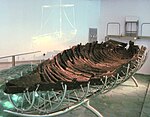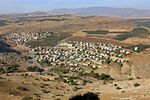Magdala

Magdala (Aramaic: מגדלא, romanized: Magdalā, meaning "tower"; Hebrew: מגדל, romanized: Migdál; Arabic: المجدل, romanized: al-Majdal; Ancient Greek: Μαγδαλά) was an ancient Jewish city on the shore of the Sea of Galilee, 5 km (3 miles) north of Tiberias. In the Babylonian Talmud it is known as Magdala Nunayya (Aramaic: מגדלא נוניה, meaning "Tower of the Fishes"), and which some historical geographers think may refer to Tarichaea, literally: "the place of processing fish." It is believed to be the birthplace of Mary Magdalene. Until the 1948 Arab–Israeli War, a small Arab village, al-Majdal, stood at the site of ancient Magdala. The Israeli municipality of Migdal now extends into the area.
Excerpt from the Wikipedia article Magdala (License: CC BY-SA 3.0, Authors, Images).Magdala
Migdal
Geographical coordinates (GPS) Address Nearby Places Show on map
Geographical coordinates (GPS)
| Latitude | Longitude |
|---|---|
| N 32.825 ° | E 35.515555555556 ° |
Address
1427943 Migdal
North District, Israel
Open on Google Maps








